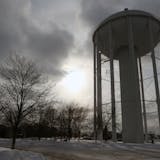Drivers in Minneapolis and St. Paul will have to slow down to 25 miles per hour on arterial streets and 20 miles per hour on residential streets starting this year, under new speed limits unveiled Thursday.
Leaders in both cities celebrated the lower speed limits in an event held in pouring rain on the municipal border line in the Prospect Park neighborhood. The cities proposed the lower speed limits last year as part of their effort to reduce traffic-related deaths and injuries and make streets safer for cyclists, pedestrians and drivers.
"There is nationally collected data that tells us that slower is safer," Minneapolis Public Works Director Robin Hutcheson said.
Whether signs alone are enough to change driver behavior or whether it will take more warnings and speeding tickets remains an open question.
Public works crews will put up the new signs — more than 1,000 in all — on arterial streets beginning Thursday. The speeds for all city streets should be changed by October, Hutcheson said.
Instead of speed limit signs on every residential street, signs at entry points to both cities will state the limit is 20 mph unless otherwise posted.
A few city streets will remain at 30 or 35 mph. Others that are 10 mph, such as alleys and Nicollet Mall, will not change, Hutcheson said.
Legislators gave local governments the authority to set speed limits on city-owned streets last year. Speed limits on state and county roads will not change.


